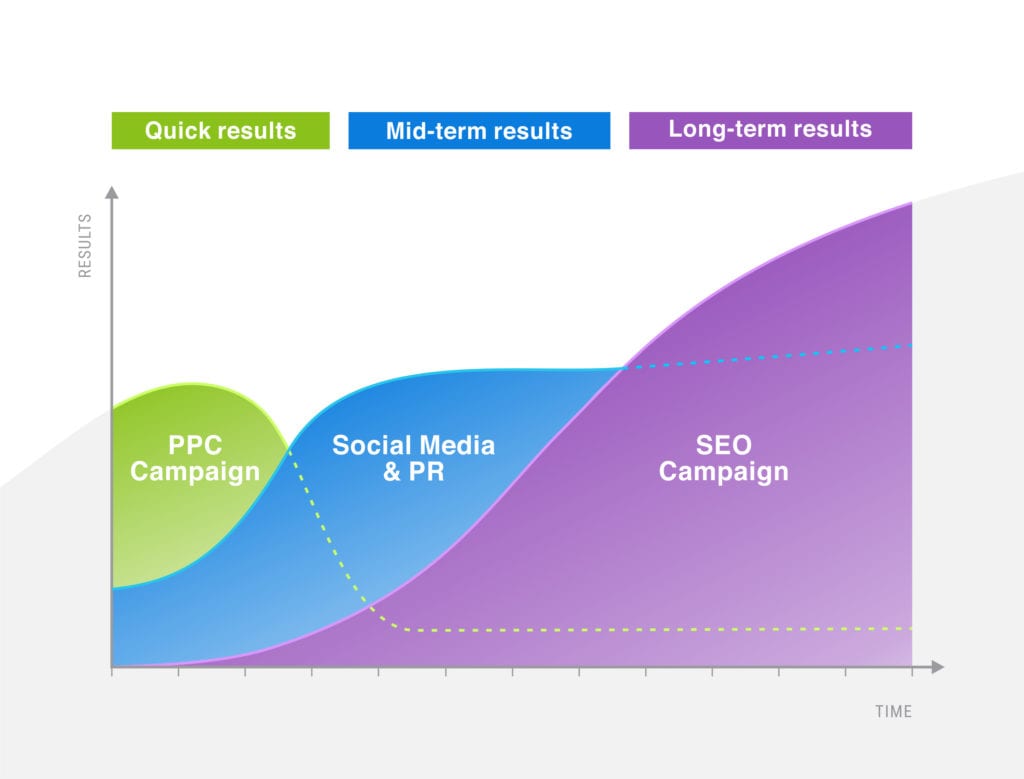What tools should you use to market your business, and in what order?

There is a plethora of marketing tools nowadays: each one creates an impact and is as important as the next. Due to budget limitations and other constraints, deciding not only which one to choose but the order in how they are utilized is a difficult process.

Most people react with urgency and prefer to allocate their efforts and their budget to prioritize achieving the quick results of PPC (Paid Ads) or the visibility of Social Media, while delaying the term growth that SEO/SEM (Search Engine Marketing) can bring at a lower cost. However, each marketing tool provides varying results depending on the stage of a business, and using them at the right time is an important detail to note of.
PPC generates an immediate traffic boost and conversion but lacks an accumulative effect. After a while, this tool becomes stagnant and delivers the same results with no further growth.
Social Media, sometimes labeled as “Digital PR,” plays a significant role in a business’s initial visibility. Unless you launch a product every month, the effects start to either fade or grow at lower rates. This depends on the amount of effort and new ideas you are consistently putting to each post. After a while, sharing the same product over and over again loses its original flare.
In the case of SEO, as an ongoing campaign with content marketing, the impact is small at the beginning. Once it starts affecting rankings, its growth rises above the other marketing techniques at a higher rate. Sales Leads coming from SEO generally show a higher closing ratio because it draws in people who actively look for your service or product, who chose to open your link voluntarily, who were not force-fed an ad at the top of their search results or interrupted by someone trying to sell them something between their family picture and the funny cat video on social media.
While SEO is consistent and trustworthy in its traffic results, this tool can still be impacted by competitors, market demand alterations, SERP modifications, and restorations in the algorithm. Overall, SEO’s efficiency is reliable and does not require a daily update or a lot of attention to continue running.
On a few occasions, SEO possesses an accelerated result. More commonly, this tool demands time and patience from the beginning for there to be a significant difference in performance growth.
As there are several factors involved in this process, there is difficulty in determining a time frame for when a website reaches a certain goal in traffic. The most advisable benchmark is an estimated period of around 3 months.
To some websites, SEO is best suited as a longer investment with no definitive end instead of a short-term project with an exact stopping point. There have been cases when SEO gains have been accomplished in a project setting, but a business can achieve better performance results when drawn out over time. More gains and positive results are seen when more time and effort is invested in this tool.
What is the best approach?
You must ensure your website is on its way to a stable SEO position before anything else, or your business will have little opportunities surviving in the long term. Yet, you can compensate for the initial, slow movement of SEO using an initial PPC campaign.
Right after your SEO traffic starts bringing in sales leads, you will need to show your newfound prospects that your company is alive and active on social media. Social Media will never bring you the same number of clients SEO will, (unless you invest heavily or become an influencer) but remains a necessary component to have after new clients find you in their searches.
PPC is fast and social media is a necessary addition to any marketing campaign. But without a solid SEO structure to sustain it all, it can become an expensive placebo. This mistake is a luxury no business can afford in a post-pandemic economy.
How aligned are your current marketing efforts with your business priorities?


